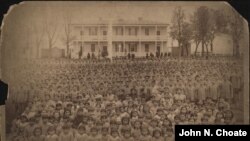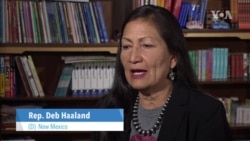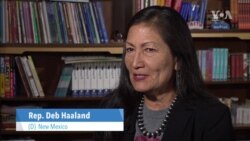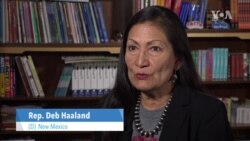Student Union
- By Julie Taboh
Education for Native Youth Is a Work in Progress

Some Native American children fear bullying and harassment so much, they hide their ethnicity at school, according to an education expert.
“A lot of Native students feel invisible,” said Katrina Boone, an associate partner at Bellwether Education Partners, a national nonprofit whose mission is to change education and life outcomes for underserved children.
Boone said many students have told her they don't feel comfortable letting their teachers know they are Native American because they have “been harassed and bullied, not just by peers, but by teachers in school.”
Native American students languish in schools across the country and often face worse outcomes than their white, black and Latino peers, she said. And the rates of high school and post-graduation trends are below the rates of their peers.
The suicide rate for Native youth exceeds the rate of their peers, Boone said. And national data indicate that rates for illicit drug use and tobacco use are higher for Native youth than for their peers, she said, citing the National Survey on Drug Use and Health from the Substance Abuse and Mental Health Services Administration (SAMHSA).
False history
Native Americans have been discriminated against “for hundreds of years,” Boone said, and forced to assimilate into a Euro-centric American culture.
“A lot of people view Native people and their socio-economic challenges and think the cause is Native people themselves,” she said. “But the actuality is that of course these challenges aren’t inherent to Native people. These are the effects of centuries of our government being terroristic, genocidal, and just generally unfair to Native American people since European first contact.”
Schools were used as a tool of assimilation, Boone said. “Very thoughtfully and very strategically by the government to destroy Native culture, to destroy Native language, to separate Native people, and to erase their cultures as they originally existed before first contact," she said.
Hundreds of thousands of Native children were sent -- often forcibly -- to Native American boarding schools where “they were punished for speaking their native language, banned from acting in any way that might be seen to represent traditional or cultural practices, stripped of traditional clothing, hair and personal belongings and behaviors reflective of their native culture,” according to the National Native American Boarding School Healing Coalition.
When they returned to their families, “they were so completely Americanized that they couldn't speak the language of their families and had lost their culture and traditions,” Boone said. The outcome is poverty, poor physical and mental health issues and subpar education outcomes “that we see in Indian country today."
Native schools
But Boone is quick to point out that there are pockets in the country where Native students excel.
“The schools where Native students excel acknowledge those students’ culture, they acknowledge those students’ Native languages, they involve communities in really rich ways, and usually those schools are controlled and run by Native people,” Boone said.
She points to the Waadookodaading Ojibwe Language Immersion School in northwestern Wisconsin, where students thrive in an academically rigorous environment that leverages the myriad assets of their Native culture and language.
There is also the Institute of American Indian Arts (IAIA), a 56-hectare (140-acre) campus in Santa Fe, New Mexico, where approximately 500 students are immersed in contemporary Native American arts and culture.
Members of about 100 tribes attend the school, President Robert Martin, a member of the Cherokee Nation, said. "So that's a lot of diversity,” he said, but the school’s main mission he points out, “will always reflect that indigenous or Native perspective.”
Dolores’ story
Native American and IAIA student Dolores Scarlett Cortez studies printmaking and photography. She said using those mediums allowed her to explore her roots. Cortez said she spent this past summer photographing members of her community, and in the process, found her calling.
“With my own indigenous cultures and especially coming to the school, I do feel like there's not enough resources on reservation land that caters to indigenous people,” she said. “I think it's really important to bring that representation back.”
The power of film
Anthony Deiter, who graduated from IAIA 25 years ago and is now a professor of virtual gaming and simulation at the school, teaches a new concept in filmmaking: moving images viewed on a spherical screen rather than a flat one.
He said he thinks the arts -- especially film -- are a powerful platform to help students understand their history, and they provide an opportunity to correct it where they can.
“We often look at those movies and go, ‘Well, that’s sort of not us,’ and I’m going ‘Well, maybe we need to start putting that voice out there. Maybe we need to take a place, like the Institute of American Indian Arts, [which] has the platform to jump off to tell our own stories,’” Dieter said.
Political push
“What I really feel needs to happen is we need to have more Native Americans in roles that we don't necessarily see them in now, or roles that we are a vast minority in,” said U.S. Congresswoman Deb Haaland, a Democrat who represents New Mexico's 1st congressional district and is one of two female Native American legislators elected to Congress.
At the University of New Mexico School of Law where Haaland graduated in 2006, she lobbied the state legislature to pass a bill giving Native Americans in-state tuition regardless of their residency. She paid out-of-state tuition at University of New Mexico School of Law because she resided in California several years before enrollment.
“I felt that I'm a Pueblo woman, and my family's been here since the 1280s, and that made me a 35th generation New Mexican. And it just seemed wrong that I had to pay out-of-state tuition," Haaland said.
She said she would like to see more Native Americans in leadership roles, especially women.
“We need more Native women CEOs. We need more Native women in public office. We need Native Americans in high military positions. We need to ensure that we are giving opportunities to not just Native Americans, but minority students all over the country," Haaland said.
Walking in two worlds
Boone, of Bellwether Education Partners, said she thinks that in order to succeed, Native Americans have to first be fully grounded in their own culture.
"New students have to understand that they live in, for better or worse, the country that we all live in today, and that there's a real need to be able to navigate that society, but with the strength within them from their first culture," she said.
"That's not different for any other kid in school," she said. "I saw in my teaching experiences that kids really need to be rooted in their families and their communities, and have some sort of cultural base.”
“Those are the kids who are the most successful," Boone said
See all News Updates of the Day
- By VOA News
Competition grows for international students eyeing Yale

It’s tough to gain admission to Yale University, and it’s getting even tougher for international students as standout students from around the world set their sights on Yale.
The Yale Dale News, the campus newspaper, takes a look at the situation here.
- By VOA News
Student from Ethiopia says Whitman College culture made it easy to settle in

Ruth Chane, a computer science major from Ethiopia, writes about her experiences settling into student life at Whitman College in the U.S. state of Washington.
"The community at Whitman College made sure I felt welcomed even before I stepped foot on campus," she says.
- By VOA News
Claremont Colleges student gets a shock when she heads home to Shanghai

In The Student Life, the student newspaper for the Claremont Colleges, a consortium of five liberal art colleges and two graduate schools in Claremont, California, student Rochelle Lu writes about readjusting to her Shanghai home after spending a semester in the United States.
- By VOA News
Cedarville University aims to ease transition for international students

Cedarville University in the U.S. state of Ohio says it’s got more than 140 international students representing 44 countries.
Here, the school interviews Jonathan Sutton, director of international student services. He talks about his job and the opportunities for international students on campus.
- By VOA News
Morehouse College offers prospective students tips on applying and thriving

Morehouse College, a private, historically Black liberal arts college in the U.S. state of Georgia, offers a guide for international students interested in attending the school.
Among the tips to apply and thrive at Morehouse:
- Take advantage of the school’s orientation program
- Turn to the school’s Center for Academic Success for tutoring, support and more
- Immerse yourself in campus life via clubs and societies
- By Reuters
US reviews Columbia University contracts, grants over antisemitism allegations

The administration of President Donald Trump said on Monday it will review Columbia University's federal contracts and grants over allegations of antisemitism, which it says the educational institution has shown inaction in tackling.
Rights advocates note rising antisemitism, Islamophobia and anti-Arab bias since U.S. ally Israel's devastating military assault on Gaza began after Palestinian Hamas militants' deadly October 2023 attack.
The Justice Department said a month ago it formed a task force to fight antisemitism. The U.S. Departments of Health and Education and the General Services Administration jointly made the review announcement on Monday.
"The Federal Government's Task Force to Combat Anti-Semitism is considering Stop Work Orders for $51.4 million in contracts between Columbia University and the Federal Government," the joint statement said.
The agencies said no contracting actions had been taken yet.
"The task force will also conduct a comprehensive review of the more than $5 billion in federal grant commitments to Columbia University."
The agencies did not respond to requests for comment on whether there were similar reviews over allegations of Islamophobia and anti-Arab bias.
Columbia had no immediate comment. It previously said it made efforts to tackle antisemitism.
College protests
Trump has signed an executive order to combat antisemitism and pledged to deport non-citizen college students and others who took part in pro-Palestinian protests.
Columbia was at the center of college protests in which demonstrators demanded an end to U.S. support for Israel due to the humanitarian crisis caused by Israel's assault on Gaza. There were allegations of antisemitism and Islamophobia in protests and counter-protests.
During last summer's demonstrations around the country, classes were canceled, some university administrators resigned and student protesters were suspended and arrested.
While the intensity of protests has decreased in recent months, there were some demonstrations last week in New York after the expulsion of two students at Columbia University-affiliated Barnard College and after New York Governor Kathy Hochul ordered the removal of a Palestinian studies job listing at Hunter College.
A third student at Barnard College has since been expelled, this one related to the occupation of the Hamilton Hall building at Columbia last year.
Canada’s immigration overhaul signals global shift in student migration
From Europe to North America, nations are tightening their immigration policies. Now Canada, long seen as one of the world's most welcoming nations, has introduced sweeping changes affecting international students. The reforms highlight a growing global trend toward more restrictive immigration policies. Arzouma Kompaore reports from Calgary.
Trump administration opens antisemitism inquiries at 5 colleges, including Columbia and Berkeley

The Trump administration is opening new investigations into allegations of antisemitism at five U.S. universities including Columbia and the University of California, Berkeley, the Education Department announced Monday.
It's part of President Donald Trump's promise to take a tougher stance against campus antisemitism and deal out harsher penalties than the Biden administration, which settled a flurry of cases with universities in its final weeks. It comes the same day the Justice Department announced a new task force to root out antisemitism on college campuses.
In an order signed last week, Trump called for aggressive action to fight anti-Jewish bias on campuses, including the deportation of foreign students who have participated in pro-Palestinian protests.
Along with Columbia and Berkeley, the department is now investigating the University of Minnesota, Northwestern University and Portland State University. The cases were opened using the department's power to launch its own civil rights reviews, unlike the majority of investigations, which stem from complaints.
Messages seeking comment were left with all five universities.
A statement from the Education Department criticized colleges for tolerating antisemitism after Hamas' Oct. 7, 2023, attack on Israel and a wave of pro-Palestinian protests that followed. It also criticized the Biden administration for negotiating "toothless" resolutions that failed to hold schools accountable.
"Today, the Department is putting universities, colleges, and K-12 schools on notice: this administration will not tolerate continued institutional indifference to the wellbeing of Jewish students on American campuses," said Craig Trainor, the agency's acting assistant secretary for civil rights.
The department didn't provide details about the inquiries or how it decided which schools are being targeted. Presidents of Columbia and Northwestern were among those called to testify on Capitol Hill last year as Republicans sought accountability for allegations of antisemitism. The hearings contributed to the resignation of multiple university presidents, including Columbia's Minouche Shafik.
An October report from House Republicans accused Columbia of failing to punish pro-Palestinian students who took over a campus building, and it called Northwestern's negotiations with student protesters a "stunning capitulation."
House Republicans applauded the new investigations. Representative Tim Walberg, chair of the Education and Workforce Committee, said he was "glad that we finally have an administration who is taking action to protect Jewish students."
Trump's order also calls for a full review of antisemitism complaints filed with the Education Department since Oct. 7, 2023, including pending and resolved cases from the Biden administration. It encourages the Justice Department to take action to enforce civil rights laws.
Last week's order drew backlash from civil rights groups who said it violated First Amendment rights that protect political speech.
The new task force announced Monday includes the Justice and Education departments along with Health and Human Services.
"The Department takes seriously our responsibility to eradicate this hatred wherever it is found," said Leo Terrell, assistant attorney general for civil rights. "The Task Force to Combat Anti-Semitism is the first step in giving life to President Trump's renewed commitment to ending anti-Semitism in our schools."
- By VOA News
STEM, business top subjects for international students

The Times of India breaks down the most popular subjects for international students to study in the U.S.
STEM and business lead the pack. Read the full story here. (January 2025)
- By VOA News
Safety and visa difficulties among misconceptions about US colleges

U.S. News & World report addresses some of the misconceptions about U.S. colleges and universities, including the difficulty of getting a visa.
Read the full story here. (January 2025)
- By VOA News
Work opportunities help draw international students to US schools

US News & World Report details the three top factors in foreign students' decision to study in the U.S. They include research opportunities and the reputation of U.S. degrees. Read the full story here. (December 2024)
- By VOA News
British student talks about her culture shock in Ohio

A British student who did a year abroad at Bowling Green State University in Ohio talks about adjusting to life in America in a TikTok video, Newsweek magazine reports.
Among the biggest surprises? Portion sizes, jaywalking laws and dorm room beds.
Read the full story here. (December 2024)
- By VOA News
Harvard's Chan School tells international students what to expect

Harvard's T.H. Chan School of Public Health reaches out to international students by detailing the international student experience at the school.
Learn more about housing, life in Boston and more here.
- By Reuters
China unveils plan to build 'strong education nation' by 2035

China issued its first national action plan to build a "strong education nation" by 2035, which it said would help coordinate its education development, improve efficiencies in innovation and build a "strong country."
The plan, issued Sunday by the Communist Party's central committee and the State Council, aims to establish a "high quality education system" with accessibility and quality "among the best in the world."
The announcement was made after data on Friday showed China's population fell for a third consecutive year in 2024, with the number of deaths outpacing a slight increase in births, and experts cautioning that the downturn will worsen in the coming years.
High childcare and education costs have been a key factor for many young Chinese opting out of having children, at a time when many face uncertainty over their job prospects amid sluggish economic growth.
"By 2035, an education power will be built," the official Xinhua news agency said, adding that China would explore gradually expanding the scope of free education, increase "high-quality" undergraduate enrolment, expand postgraduate education, and raise the proportion of doctoral students.
The plan aims to promote "healthy growth and all-round development of students," making sure primary and secondary school students have at least two hours of physical activity daily, to effectively control the myopia, or nearsightedness, and obesity rates.
"Popularizing" mental health education and establishing a national student mental health monitoring and early warning system would also be implemented, it said.
It also aims to narrow the gap between urban and rural areas to improve the operating conditions of small-scale rural schools and improve the care system for children with disabilities and those belonging to agricultural migrant populations.
The plan also aims to steadily increase the supply of kindergarten places and the accessibility of preschool education.
- By VOA News
A look at financial aid options for international graduate students in US

The Open Notebook, a site focusing on educating journalists who cover science, has complied a list of U.S. graduate program financial aid information for international students.












